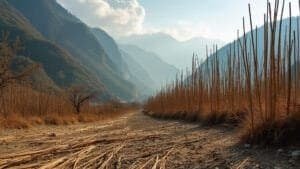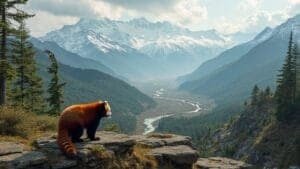Introduction
Climate change is impacting red panda habitats in the Himalayas, creating new challenges for this endangered species. Rising temperatures, shifting precipitation patterns, and extreme weather events threaten the stability of red panda ecosystems, affecting their access to food and suitable living spaces
This article examines the specific ways climate change affects red panda habitats, from temperature-driven shifts in altitude to changes in bamboo availability and the increasing prevalence of extreme weather
Understanding these impacts is essential for developing effective conservation strategies that ensure the survival of red pandas in a warming world
Temperature and Altitude Shifts in Red Panda Habitats
Rising temperatures in the Himalayan region are driving significant changes in red panda habitats, affecting everything from their health to their preferred altitude range
As temperatures increase, red pandas are forced to migrate to higher altitudes to find cooler environments, but this shift presents new challenges
The effects of warming temperatures are especially pronounced in high-altitude species like the red panda, whose survival depends on specific temperature ranges and stable habitats
Impact of Rising Temperatures on Red Panda Health
Red pandas are adapted to cold, temperate climates and struggle to tolerate high temperatures. As the Himalayas experience rising temperatures, red pandas become more vulnerable to heat stress, especially during warmer seasons
Heat stress can lead to reduced activity levels, lower food intake, and compromised immune function, making red pandas more susceptible to illness
According to Wei and Zhang (2020), red pandas in habitats experiencing temperature increases above 1°C show signs of behavioral changes, such as seeking shaded areas more frequently and reducing activity during peak daytime hours
These adaptations are responses to avoid overheating, but they also limit the time red pandas can spend foraging, which affects their nutritional intake and overall health
Altitude Migration Due to Climate Warming
In response to warming temperatures, red pandas are gradually migrating to higher altitudes to maintain their ideal temperature range
This migration can help them avoid the heat but creates other ecological challenges. Higher altitudes have reduced bamboo availability, as well as steeper terrain that can limit movement and increase energy expenditure
Rai and Sherpa (2022) found that red pandas living above 10,000 feet face more significant food scarcity, as bamboo becomes sparser at these elevations
Furthermore, high-altitude migration concentrates red panda populations into smaller, fragmented habitats, increasing competition for limited resources and the likelihood of inbreeding, which poses additional risks for long-term survival
Challenges in High-Altitude Habitat Adaptation
Adapting to high-altitude habitats presents challenges for red pandas due to the thinner air, reduced plant diversity, and harsher weather conditions
Red pandas moving to higher elevations must adjust to lower oxygen levels, which can affect their overall stamina and health. Additionally, steep, rocky terrain makes movement more difficult, reducing their ability to forage efficiently
High-altitude shifts also reduce habitat availability, as there is limited land area at higher elevations. This restricted habitat puts increased pressure on red panda populations, heightening the risk of genetic bottlenecks and decreasing resilience to environmental changes
Addressing these challenges is essential for supporting red pandas in adapting to climate-driven altitude shifts
Effects on Bamboo Availability and Food Sources
Bamboo is the primary food source for red pandas, but climate change is impacting bamboo growth and availability in the Himalayan region
As temperatures and precipitation patterns shift, bamboo habitats are being affected, leading to seasonal fluctuations and reduced bamboo density. These changes present serious challenges for red pandas, as stable access to bamboo is essential for their survival
Bamboo Growth and Climate Dependency
Bamboo growth is highly sensitive to climate conditions, particularly temperature and precipitation. Increases in temperature and variability in rainfall patterns can disrupt bamboo growth cycles, reducing both the quantity and nutritional quality of bamboo in red panda habitats
Bamboo species adapted to specific temperature ranges may struggle to survive as these ranges shift, leaving red pandas with fewer food sources
Thapa and Lama (2021) report that bamboo in lower-altitude areas, which red pandas previously relied on, is showing reduced growth due to warmer temperatures
This shift limits red pandas’ access to fresh, nutrient-rich bamboo, affecting their diet and making them more susceptible to nutritional deficiencies, especially in regions where bamboo is already sparse
Seasonal Shifts in Bamboo Availability
Climate change has also altered the seasonal patterns of bamboo growth and flowering, creating unpredictable food availability for red pandas
Unusual flowering cycles or bamboo die-offs, which are increasingly linked to climate variability, can lead to food shortages, as bamboo takes years to regenerate after flowering
Red pandas facing these shortages are forced to spend more time foraging, increasing their energy expenditure and exposure to predators
Seasonal shifts in bamboo availability also disrupt red pandas’ feeding schedules, affecting their body condition and reproductive success. When bamboo becomes scarce, red pandas may struggle to build adequate fat reserves, which are essential for surviving the colder winter months when food sources are naturally more limited
Impact on Red Panda Feeding and Nutrition
A disrupted bamboo supply affects red pandas’ overall nutrition, as bamboo is low in protein and red pandas need to consume large quantities to meet their energy needs
If bamboo availability declines, red pandas may have to supplement their diet with other vegetation, which may not provide the necessary nutrients and could strain their digestive systems
This dietary shift can lead to malnutrition and weakened immune systems, making red pandas more vulnerable to illness and environmental stress
These changes in feeding and nutrition underscore the importance of maintaining bamboo-rich habitats to support red panda health. Conservation efforts focused on restoring and protecting bamboo groves are crucial in helping red pandas adapt to these climate-related shifts in their food supply
Changing Precipitation Patterns and Habitat Health
Changing precipitation patterns, including reduced snowfall and increased rainfall, are affecting the overall health of red panda habitats in the Himalayas
Precipitation directly impacts water resources, vegetation health, and soil stability, all of which are essential for supporting red panda populations. Shifts in precipitation can lead to habitat degradation, making it difficult for red pandas to access water and food resources
Effects of Reduced Snowfall on Water Resources
Red pandas rely on forested mountain ecosystems where seasonal snowfall is critical for maintaining water availability throughout the year. Reduced snowfall in the Himalayas leads to a decreased snowmelt, which directly impacts river and stream levels
Lower water availability not only affects red panda hydration needs but also influences bamboo growth, as bamboo requires consistent moisture to thrive
As snowfall decreases, red pandas may need to travel longer distances to find water, increasing their energy expenditure and exposure to predators
According to research by Rai and Sherpa (2022), changes in water availability impact red panda feeding and foraging behaviors, emphasizing the need to preserve water resources within their habitats
Increased Rainfall and Erosion in Red Panda Habitats
While some areas experience reduced snowfall, others see increased rainfall, which can lead to erosion and soil instability. Heavy rain can wash away topsoil, damaging bamboo groves and reducing the overall vegetation cover in red panda habitats
Erosion also makes terrain more hazardous, impacting red pandas’ ability to move freely and access foraging sites
In addition, increased rainfall contributes to habitat fragmentation, as erosion and landslides can separate bamboo patches and create physical barriers
This fragmentation isolates red panda populations, limiting genetic diversity and reducing habitat connectivity, which is vital for red pandas’ survival and adaptation to environmental changes
Adaptation Challenges Due to Precipitation Changes
Adapting to new precipitation patterns poses challenges for red pandas, whose habitats are increasingly subject to sudden shifts between dry and wet conditions
These changes force red pandas to modify their behaviors and travel patterns to adapt to fluctuating water and food availability. When faced with inconsistent precipitation, red pandas experience more stress in meeting their dietary and hydration needs, impacting their overall health and reproductive success
These changes in precipitation underscore the importance of maintaining stable forest environments for red pandas. Conservation strategies that prioritize soil stabilization and water management are critical in reducing the impact of these changes on red panda habitats, supporting habitat resilience in the face of climate variability
Extreme Weather Events and Habitat Stability
Extreme weather events, including landslides, forest fires, and storms, are becoming more frequent due to climate change, posing significant threats to red panda habitats
These events can cause sudden and extensive habitat destruction, disrupt red panda foraging patterns, and threaten their overall survival. Addressing the impact of these extreme events is essential for developing resilient conservation strategies that protect red panda populations
Frequency of Landslides and Forest Fires
Landslides, often triggered by heavy rainfall, are increasingly common in the Himalayan region, particularly in deforested or fragmented areas where soil stability is compromised
These landslides can devastate red panda habitats by destroying bamboo groves, disrupting access to resources, and even causing direct harm to red pandas
Forest fires, while less frequent, also present risks as they destroy vegetation and create barren areas that take years to recover, significantly impacting red panda food sources and shelter
Forest management practices that stabilize soil and reduce erosion risks can help mitigate the impact of landslides. Thapa and Lama (2021) emphasize that planting native vegetation, including bamboo, helps stabilize slopes, making habitats more resilient to landslides and fires
Impact of Storms on Forest Structure
Severe storms are another threat to red panda habitats, as strong winds and heavy rains can damage trees, bamboo patches, and other essential vegetation. Fallen trees and debris create physical barriers that limit red pandas’ movement, making it more difficult for them to access food and shelter
Storms also strip vegetation, affecting the canopy cover that provides shade and temperature regulation within the forest, which red pandas rely on to avoid overheating during warmer months
The increased frequency of storms further complicates the red panda’s ability to adapt to its changing habitat, as forest structure changes more rapidly than they can adjust
Conservationists are exploring ways to protect critical forest areas from storm damage, ensuring that red pandas retain access to food and shelter even as extreme weather events become more frequent
Conservation Responses to Extreme Events
To counteract the effects of extreme weather events, conservationists are implementing strategies that prioritize habitat stability and rapid recovery following disruptions
One approach involves creating buffer zones around red panda habitats, where vegetation is carefully managed to reduce fire risk and prevent soil erosion. Additionally, reforestation projects aim to restore damaged habitats, ensuring that red pandas have access to healthy forests that can withstand extreme conditions
Building resilience in red panda habitats requires collaboration with local communities to adopt sustainable land-use practices, such as controlled burns and soil stabilization techniques
By engaging local stakeholders, conservation efforts can reduce the risks of extreme weather while enhancing habitat stability for red pandas, promoting both species survival and ecological balance
Conclusion
Climate change is transforming red panda habitats in the Himalayas, presenting a range of challenges that threaten their survival
Rising temperatures are pushing red pandas to higher altitudes, where food and space are limited, while shifts in precipitation disrupt water resources and increase erosion in their forested environments
The effects on bamboo availability, extreme weather events, and habitat fragmentation intensify these challenges, making red pandas more vulnerable in their already limited habitats
Conservation strategies are evolving to address these impacts, focusing on habitat restoration, soil stabilization, and sustainable land management. By collaborating with local communities and implementing preventative measures, conservationists aim to mitigate the effects of climate change, enhancing the resilience of red panda habitats
As we work to protect these unique animals, understanding and adapting to climate-related challenges is essential for preserving red pandas and their Himalayan ecosystems for future generations





